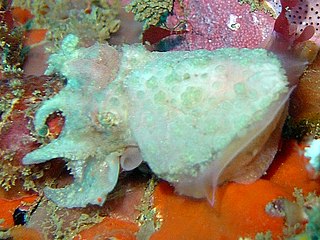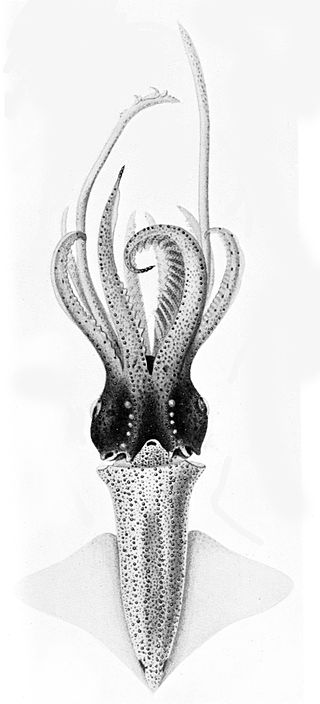
Stauroteuthis is a genus of deepwater cirrate octopus, a cephalopod mollusk. This is the only genus in the family Stauroteuthidae, and only three species have been described in this genus.
Sepia faurei is a species of cuttlefish native to the southwestern Indian Ocean, specifically to the east of the Cape of Good Hope, South Africa. It lives at depths to 168 m.
Sepia hieronis is a species of cuttlefish native to the southeastern Atlantic Ocean and southwestern Indian Ocean, specifically southern Namibia, from approximately 27°S to Port Alfred, South Africa, and east Africa from 17°S to Kenya and Mozambique. It is also present in the Saya-de-Malha Bank. It lives at depths of between 43 and 500 m, although it is most abundant at 110 to 250 m depth.
Sepia australis, the southern cuttlefish, is a species of cuttlefish which is found in the eastern South Atlantic Ocean and the western Indian Ocean off the coasts of Southern Africa, possibly extending into the waters off East Africa.
Sepia pulchra is a species of cuttlefish native to the southeastern Atlantic Ocean, specifically off the Cape Peninsula in South Africa. It lives at depths of between 15 and 50 m.
Sepia robsoni is a species of cuttlefish known only from its type locality, Hout Bay in South Africa. It lives at depths of between 17 and 37 m.

Sepia tuberculata is a species of cuttlefish native to South African waters from Melkbosstrand to Knysna. It belongs to the genus Sepia. It lives in very shallow water to a depth of 3 m. It is endemic.
Inioteuthis capensis is a species of bobtail squid native to the southeastern Atlantic Ocean, specifically from Lüderitz Bay to Mossel Bay off South Africa.
Austrorossia enigmatica is a species of bobtail squid native to the southeastern Atlantic Ocean; it occurs off the coast of southern Africa from Namibia to Cape Province. It lives at depths from 276 to 400 m.
Heteroteuthis dagamensis is a species of bobtail squid native to the southeastern Atlantic Ocean and southwestern Indian Ocean. It occurs off western, southern, and southeastern Africa.

Velodona togata is a species of octopus in the monotypic genus Velodona. First described by Carl Chun in 1915, with a second subspecies discovered by Guy Coburn Robson in 1924, it was named for the distinctive membranes on its arms.

Abraliopsis morisii is a species of bioluminescent squid in the family Enoploteuthidae. The species occurs in tropical to warm temperate waters in the Atlantic Ocean, including the Gulf of Mexico and the Mediterranean Sea. It can be found in the epipelagic and mesopelagic zones. Jean Baptiste Vérany described the species in 1839 and it reaches lengths of 25 to 33 millimetres. It is rated as least concern by the International Union for Conservation of Nature (IUCN).

The colossal squid is the world’s largest squid species and the world’s largest mollusc. It belongs to the Cranchiidae family, that of the cockatoo squids or glass squids. It is sometimes called the Antarctic cranch squid or giant squid and is believed to be the largest squid species in terms of mass. It is the only recognized member of the genus Mesonychoteuthis and is known from only a small number of specimens. The species is confirmed to reach a mass of at least 495 kilograms (1,091 lb), though the largest specimens—known only from beaks found in sperm whale stomachs—may perhaps weigh as much as 600–700 kilograms (1,300–1,500 lb), making it the largest known invertebrate. Maximum total length has been estimated between 10 metres (33 ft) and 14 metres (46 ft) but the former estimate is more likely. The colossal squid has the largest eyes of any known creature ever to exist, with an estimated diameter of 27–30 cm (11–12 in) to 40 cm (16 in) for the largest collected specimen.

Todaropsis eblanae, also known as the lesser flying squid, is a species of short finned squid in the monotypic genus Todaropsis of the family Ommastrephidae.
Stauroteuthis gilchristi is a species of small pelagic octopus found at great depths in the south Atlantic Ocean. It is believed to be one of a very small number of octopuses to exhibit bioluminescence, like its sister taxon Stauroteuthis syrtensis.
Abraliopsis chuni is a species of enoploteuthid cephalopod known from Indo-Pacific waters. Very little is known of this species.
Abraliopsis falco is a species of enoploteuthid cephalopod found in the tropical waters of the East Pacific Ocean, and is known from Chile, Colombia, Costa Rica, Ecuador, El Salvador, Guatemala, México, Nicaragua, Panamá, Perú and the United States. Females are larger than males, reaching sizes of 41–46 mm mantle length, with males reaching 35–37 mm mantle length.

Abraliopsis hoylei is a species of enoploteuthid cephalopod whose type locality is the Mascarene Islands, but this is uncertain, and the type specimen has been damaged, making taxonomic determination difficult.
Abraliopsis lineata is a species of enoploteuthid cephalopod native to Indo-Pacific waters, from the Arabian Sea and the Mascarene Islands in the west to Japan, Indonesia and French Polynesia in the east. It occurs in relatively shallow water at depths of ~100 m during the day.
Abraliopsis pacificus is a species of enoploteuthid cephalopod from the northwestern Pacific Ocean, from Japan to Hawaii. This species undergoes vertical migration from 900–500 m depth during the day, rising to 263–102 m depth at night. Male spermatophores are 6.5–7 mm in length.








